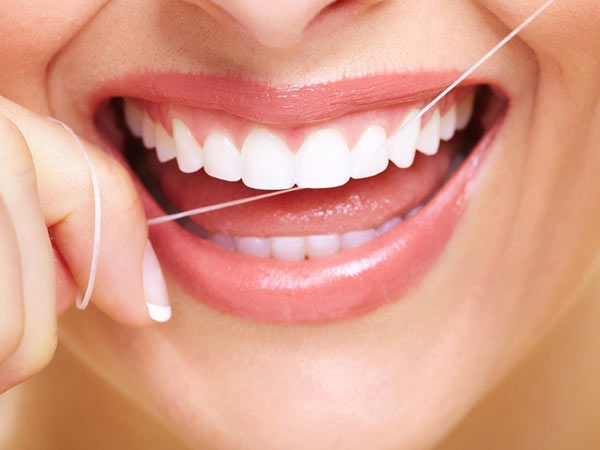Flossing is one of the most difficult things to get my patients to incorporate into their daily routine. Why do some people floss, while others struggle? Why do some people get the importance while others bring up every excuse in the world to avoid it? We know most of you hate it, but flossing really does preserve the health and aesthetics of your smile.
What many of these non-flossers don’t realize is that this step plays an important role in dental health. Unlike a toothbrush, which cleans the tops and outer surfaces of the teeth and gums, floss is an interdental tool. It is specifically made to remove harmful plaque from the tight spaces between the teeth and underneath the gums.
An increasing body of evidence suggests that proper dental care, including regular flossing can do more than keep your smile pretty and healthy. A healthy mouth can also help prevent much more serious diseases, some of which can be life threatening. But if you’re still not convinced that you should add flossing to your daily routine, please read the following examples that may motivate you to become healthier as a whole.
- Flossing and brushing are more effective together
If you’re like a lot of patients, your first response to the flossing recommendation that your dental hygienist will suggest might be, “I brush my teeth, so I’m fine.” While brushing your teeth twice a day will go a long way toward maintaining oral health, you’re not getting the optimal cleaning if you leave the floss unused in the back of your medicine cabinet.
A toothbrush works by physically removing plaque from your teeth with its soft bristles. Toothpaste enhances the effect of the toothbrush. It also may contain fluoride which helps reduce the risk of tooth decay. But brushing alone has one big drawback, it cannot adequately clean between the teeth or under the gums! That’s where floss comes in. This AMAZING tool is specifically made to remove plaque from the tight spaces between the teeth and under the gums.
- Flossing helps protect your gums
Teeth are situated in the gums and jaw. At the root of this structure, literally, are the bones of the lower and upper jaws. The jaws anchor the teeth by their roots, and the bones and roots are covered by the soft, sensitive tissue of the gums.
The places where the gums and teeth meet are where flossing plays its major role. Tiny particles of food get lodged here, and plaque in this area will harden and accumulate over time to form tartar, a thick deposit that only a dental professional can remove. Tartar buildup can lead to gingivitis: red, swollen gums that are the first stage of gum disease. If left unchecked, the bacteria-laden tartar and plaque can spread even deeper below the gum line, causing periodontitis: severe gum disease characterized by severe inflammation and eventual tooth and bone loss.
- Flossing helps prevent other diseases
Tooth and gum disease can have effects that go far beyond discolored teeth, discomfort or just plain ol’ bad breath. Extensive research has shown that the bacteria that flourish in an unhealthy mouth can harm the rest of the body, leading to heart disease, diabetes and respiratory illness. This is such a significant issue that, in 2003, the Centers for Disease Control and Prevention began calling for public health initiatives to address oral health as a step toward addressing these potentially life-threatening systemic diseases.
Heart disease is the leading cause of death in the United States, and more than 25 million Americans have diabetes. If periodontal disease, disease of the teeth, gums and mouth, contribute to these systemic diseases, then a tool that helps improve oral health can play a major role in improving public health. Flossing only takes a few minutes every day, and adds little to the cost of toothpaste, toothbrushes and mouthwash. It’s a small, simple step that can have huge implications for your long-term health.
- Flossing helps prevent tarter build up
Few parts of a regular dental visit are as uncomfortable as the scraping the hygienist must do to remove tartar. Tartar is a hard buildup of plaque that forms around the gum line. Once it’s there, it can’t be removed without professional help. But thanks to floss, health-conscious individuals have a powerful tool to fight this stubborn problem.
Flossing allows you to remove the plaque that causes tartar while it’s in its early form: sticky, but soft and pliable. Since plaque doesn’t harden into tartar until it’s been undisturbed for a period of time, regular flossing can keep buildup from happening, or making the scraping a minimal as possible.
Proper Flossing Technique
After all this talk about the importance of flossing, do you even know how to properly floss your teeth?
Pull out about 18 inches of floss, wrapping the ends around your fingertips for better control. Gently slide the floss between your teeth, being careful not to jam it into your sensitive gums. Curve the floss around each tooth, mimicking a “C” shape and rub it up and down to scrape away plaque. Avoid sawing motions with the floss, as that can damage your gums over time. Follow with a proper brushing cycle of a recommended 2-3 minutes.
Can you spare one minute out of your day to incorporate this important tool into your daily hygiene routine? The dental hygiene team at Cascades Center for Dental Health would love to guide and motivate you along this journey.


